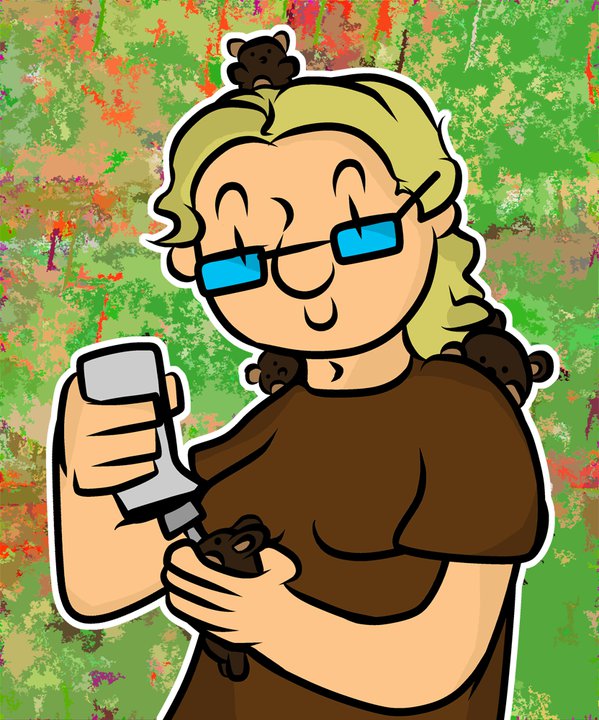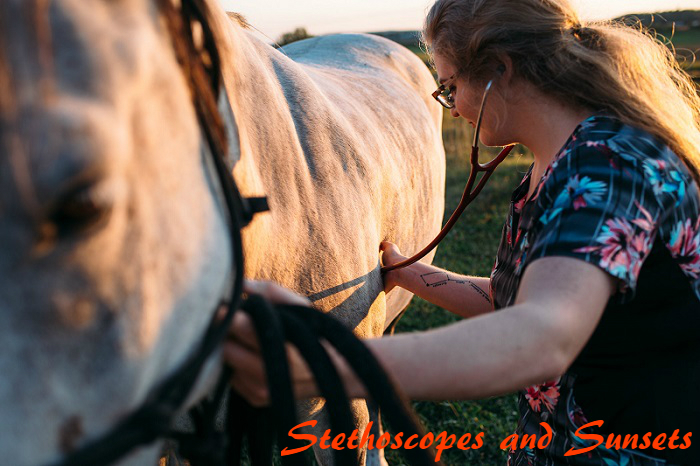
[A very talented friend of mine drew this picture of me after I came home from my second trip to volunteer in wildlife rehab in Thailand. It’s true that raising wild babies (in this case, civets) is one of the highlights of wildlife medicine — but the lowlights exist all the same.]
My time volunteering and working with wildlife — both in Canada and Thailand — was some of the most rewarding work I’ve done in the veterinary field. I saw some very amazing and special things, experiencing the joy of successful rehabilitation and release in both countries. But wildlife rehab is not without its low points and certainly some days were worse than other in the amount of pain and suffering we saw and did our best to treat. Often, the only option was a quick and painless end. Veterinary medicine is a turning coin of life and death at the best of times, euthanasia and recovery, and wildlife medicine is no different. And just like my time in ‘traditional’ vet med, some cases stick with me.
It’s two-thirty in the afternoon. There’s a kennel on the counter. There’s a squirrel inside. It’s going to die.
It’s a small kennel. A cat carrier, really. For a small cat. It’s green and brown and a little dented up, white flowers of plastic blooming where it’s bumped against things. The door is metal. It’s covered with a pale towel so that you can’t see inside, so that whatever’s inside can’t see out. Stress relief. For the animal, anyway. Funny how that works. A towel draped over a kennel means the animal’s stress level goes down and yours goes up, because a towel draped over a kennel means another animal and another decision and another life to weigh in the balance.
You know there’s a squirrel inside because of the white intake form on top of the kennel, someone’s quick-scratched handwriting. All capitals. Makes it easy to read. You know it’s a squirrel because of the species code. SCCA. Sciurus carolinensis. Sometimes you accidentally say the code out loud, skaa. Depends on how tired you are. Either way you know what it is, eastern gray squirrel, and you know it’s an adult because someone’s circled the little A on the form. You don’t even have to look inside. But last week there was a SCCA, a skaa because you were so tired that day, and the little A wasn’t circled and the little I was circled instead, for infant, and so you told the intern to go ahead and grab it and so she didn’t wear her gloves and then she screamed and when you turned around there was a nice big adult skaa hanging off her hand with all four sets of claws and a nice big set of adult skaa teeth sunk into her finger. So this time, you flip the towel up and take a peek, and sure enough there’s an adult squirrel in there.
It lies on its side with its front paws clenching and unclenching, breathing raggedly through an open mouth. It doesn’t seem to see you. It stares straight ahead through unblinking eyes. You go to drop the towel back down and when the light flickers it tenses up. Every limb extends, the head snaps back. Seizure. You drop the towel. Decrease its stress levels. Except probably not. You grab the intake form but you already know what you’re going to find. Found on the road. Someone’s added hit by car (?) in a different color pen. They’re probably right. The people who found it say that it was circling, twitching. Inside the kennel, inside its skull, its brain is swelling. Pressing against bone. Neurons firing randomly, compressed and damaged. Circling. Twitching. Seizures. Symptoms of a cause that you hate because sometimes you can fix it and sometimes you can’t and you never, ever know.
You flip up the towel and open the kennel again. The squirrel lies still. You grab a stethoscope, pediatric head so tiny it feels like a toy in your hands. Like you’re a kid again, playing vet with your stuffed animals. You listen to the lungs. Left side first. Like your stuffed animals, you hear no breath. Unlike them, there’s a heatbeat. Arrhythmic. Slow, fast, slow again. It jumps and stops and starts. When you move to the left side you can hear breathing, but it’s slow. It crackles and bubbles. Liquid in the chest cavity. Under your fingers the ribs feel strange. The abdomen is taut. When you slide your hands under the small body and pull it into the light the pupils don’t constrict but remain fixed and dilated. It’s going to die. You can wait for it to happen — it won’t be long, you think. Oxygen saturation in the bloodstream will be dropping. As blood pools in the abdominal cavity, pressure will drop. The brain will swell too far. Something will be the tipping point and the little heartbeat, skipping under your fingers, will stutter to a halt.
Or you can end it. It takes two keys and a lock-code to get into the box underneath the sink, the one with a bottle of pinkish liquid. There are other bottles in there too. You take the smaller one first, draw up a syringe of clear fluid from the hand-labled glass. The needle goes into the big muscle in the leg and the squirrel tenses, chitters at you. As you draw your hand away it tries to bite but can’t quite raise its head. Instead, it falls into another seizure. You cover it and wait for the sedative to take effect. Sometimes that’s all it takes.
You finish the paperwork. Initials, dates, signatures. Reasons for euthanasia. Everything in the log that lives in the locked cupboard, everything in the big book of intakes. It’s the first one today. It won’t be the last. There will be a pine sisken with the most beautiful colors, bright feathers on a body so ravaged by salmonella that it can no longer stand. There will be a raven, wing rotting at its side from the dog bite which broke both radius and ulna and left great weeping punctures which bleed maggots onto the exam table after it dies. But you don’t know this yet. All you know is amount withdrawn, amount remaining, route used, date of use, reason for use. Pink liquid in a clear syringe, waiting.
You go back to the squirrel. It lies still and limp, but it still breathes. Its eyes are open. Unseeing. It feels nothing, you know, floating on a ketamine sea. You look for a vein without hoping to find one; his blood pressure is far too low for the little tendrils of blue to be visible at the surface. You find the place at his ribs where his heart beats strongest. It’s slower now, but steadier. The right side of his ribcage rises and falls. The left side does not. When your needle slides between the thin ribbons of bone there is a small flash of blood into your syringe. You pull back on the plunger. No more enters. You reposition, pull back a second time. This time the blood flows brightly through the hub of the needle. The pink turns red as you inject into the heart. More than half remains when you feel the beating stop. You continue anyway.
When you pull out, no blood oozes onto the fur. It trickles from his nose instead, coming up from collapsed and drowned lungs as the muscles relax. You tap his eye and get no answering reflex of blinking lids. When you use your stethoscope, there is nothing to hear except, faintly, your own heart in your ears. Beating just a little too quickly.
Then, something else at the edge of your hearing. You pull out the earpieces and it resolves into a steady beep, gratingly loud. One of the timers for the baby birds. It’s already awake; you can hear it begin to stir in the incubator.
You wrap the masking-tape tag around the squirrel’s foreleg. Place it in a box, place the box on top of the refrigerator. It’s two thirty-nine and there’s an empty kennel on the counter. There’s no squirrel inside, because it’s dead. But your baby bird is not. It gapes widely, hungry for the slurry you syringe down its crop. A European starling. EUST. Youst; you’re tired. It shrieks at you. You feed it. The day continues.
